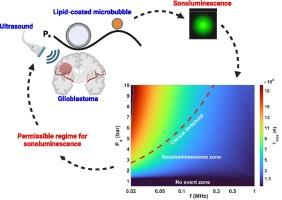Deciphering the hydrodynamics of lipid-coated microbubble sonoluminescence for sonodynamic therapy
IF 8.7
1区 化学
Q1 ACOUSTICS
引用次数: 0
Abstract
Sonodynamic therapy (SDT) is a minimally invasive targeted cancer therapy that uses focused low-intensity ultrasound (<10 MPa, <10 W/cm2) to activate sonosensitizer drugs. Once activated, these chemical compounds generate reactive oxygen species (ROS) to damage and kill cancer cells. A Phase I clinical trial has shown promising results for treating glioblastoma with SDT. We hypothesize that the efficacy of SDT can be improved by introducing lipid-coated microbubbles that produce a sonochemical effect that enhances ROS production. We investigate the hydrodynamics of a U.S. Food and Drug Administration (FDA)-approved microbubble, Lumason®, and a phospholipid-coated oxygen microbubble to predict the ultrasound parameters that induce sonoluminescence onset in biophysically relevant medium (e.g., water and blood) under clinical SDT conditions. The threshold pressures and frequencies for sonoluminescence with these therapeutic agents lie between 20 kHz – 1 MHz and 0.05 MPa – 1 MPa, respectively. The lipid-coated oxygen microbubble exhibits stronger sonoluminescence than the Lumason® microbubble, suggesting its use for improving SDT efficacy.

解密用于声动力疗法的脂质包裹微气泡声致发光的流体力学。
声动力疗法(SDT)是一种微创癌症靶向疗法,它利用聚焦低强度超声(2)激活声敏化剂药物。这些化合物一旦被激活,就会产生活性氧(ROS),从而破坏和杀死癌细胞。一项 I 期临床试验显示,SDT 治疗胶质母细胞瘤的效果很好。我们假设,通过引入脂质包裹的微气泡,可以提高 SDT 的疗效,因为微气泡会产生声化学效应,从而增强 ROS 的产生。我们研究了美国食品和药物管理局(FDA)批准的微气泡 Lumason® 和磷脂包裹的氧微气泡的流体动力学,以预测在临床 SDT 条件下在生物物理相关介质(如水和血液)中诱发声发光的超声参数。这些治疗剂的超声发光阈值压力和频率分别在 20 kHz - 1 MHz 和 0.05 MPa - 1 MPa 之间。与 Lumason® 微气泡相比,脂质包覆的氧气微气泡显示出更强的声发光,这表明它可用于提高 SDT 的疗效。
本文章由计算机程序翻译,如有差异,请以英文原文为准。
求助全文
约1分钟内获得全文
求助全文
来源期刊

Ultrasonics Sonochemistry
化学-化学综合
CiteScore
15.80
自引率
11.90%
发文量
361
审稿时长
59 days
期刊介绍:
Ultrasonics Sonochemistry stands as a premier international journal dedicated to the publication of high-quality research articles primarily focusing on chemical reactions and reactors induced by ultrasonic waves, known as sonochemistry. Beyond chemical reactions, the journal also welcomes contributions related to cavitation-induced events and processing, including sonoluminescence, and the transformation of materials on chemical, physical, and biological levels.
Since its inception in 1994, Ultrasonics Sonochemistry has consistently maintained a top ranking in the "Acoustics" category, reflecting its esteemed reputation in the field. The journal publishes exceptional papers covering various areas of ultrasonics and sonochemistry. Its contributions are highly regarded by both academia and industry stakeholders, demonstrating its relevance and impact in advancing research and innovation.
 求助内容:
求助内容: 应助结果提醒方式:
应助结果提醒方式:


